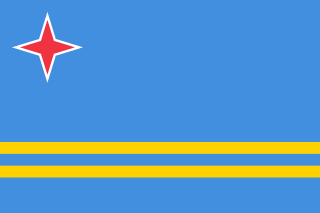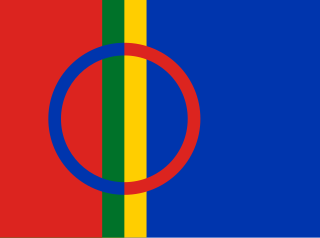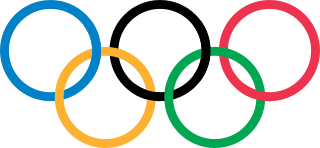
The Flag of Europe or European Flag is an official symbol of the 46-nation, Strasbourg-based Council of Europe (CoE). Consisting of a circle of twelve golden stars on a blue field, it was designed in 1955 and adopted by the CoE that same year.

A national flag is a flag that represents and symbolizes a given nation. It is flown by the government of that nation, but usually can also be flown by its citizens. A national flag is typically designed with specific meanings for its colours and symbols, which may also be used separately from the flag as a symbol of the nation. The design of a national flag is sometimes altered after the occurrence of important historical events. The burning or destruction of a national flag is a greatly symbolic act.

Aruba's national flag was adopted on 18 March 1976. The design consists of a field of light blue, two narrow parallel horizontal yellow stripes in the bottom half, and a four-pointed white-fimbriated red star in the canton. The flag was designed in part by vexillologist Whitney Smith.

A compass rose, sometimes called a wind rose, rose of the winds or compass star, is a figure on a compass, map, nautical chart, or monument used to display the orientation of the cardinal directions and their intermediate points. It is also the term for the graduated markings found on the traditional magnetic compass. Today, a form of compass rose is found on, or featured in, almost all navigation systems, including nautical charts, non-directional beacons (NDB), VHF omnidirectional range (VOR) systems, global-positioning systems (GPS), and similar equipment.

The flag of Guatemala, often referred to as "Pabellón Nacional" or "Azul y Blanco" features two colors: Sky blue and white. The two Sky blue stripes represent the fact that Guatemala is a land located between two oceans, the Pacific Ocean and the Atlantic Ocean ; and the sky over the country. The white signifies peace and purity. The blue and white colors, like those of several other countries in the region, are based on the flag of the former Federal Republic of Central America.

The national flag of Malaysia, also known as the Stripes of Glory, is composed of a field of 14 alternating red and white stripes along the fly and a blue canton bearing a crescent and a 14-point star known as the Bintang Persekutuan. The 14 stripes, of equal width, represent the equal status in the federation of the 13 member states and the federal territories, while the 14 points of the star represent the unity between these entities. The crescent represents Islam, the country's state religion; the blue canton symbolises the unity of the Malaysian people; the yellow of the star and crescent is the royal colour of the Malay rulers.

The flag of Barbados was designed by Grantley W. Prescod and was officially adopted to represent the nation of Barbados at midnight on 30 November 1966, the day the country gained independence. The flag was chosen as part of a nationwide open contest held by the government, with Prescod's design being selected as the winner of a field of over one thousand entries. The flag is a triband design, with the outermost stripes coloured ultramarine, to represent the sea and the sky, and the middle stripe coloured gold, to represent the sand. Within the middle band is displayed the head of a trident. This trident is meant to represent the trident of Poseidon, visible in Barbados's colonial coat of arms, and the fact that it is broken is meant to represent the severed ties between Barbados and the United Kingdom, of which it was long a colony.

The flag of Uzbekistan consists of three horizontal azure, white and green bands separated by two thin red fimbriations, with a crescent moon and twelve stars at the canton. Adopted in 1991 to replace the flag of the Uzbek Soviet Socialist Republic (SSR), it has been the flag of the Republic of Uzbekistan since the country gained independence in that same year. The design of the present flag was partly inspired by the former one.

The flag of Colorado was designed by Andrew Carlisle Carson and officially adopted to represent the U.S. state of Colorado on June 5, 1911. It consists of a fess design of three horizontal stripes of equal width, with the top and bottom stripes colored blue, and the middle stripe colored white. A circular red "C", filled with a golden disk, sits atop the stripes. All aspects of the flag contain symbolism related to the state, as the blue is meant to represent the sky, the gold for the abundant sunshine the state receives, and the white for the snowcapped Rocky Mountains, and the red represents the "ruddy" earth. The gold and white portions of the flag also represent to the state's gold and silver mining industries, respectively.

The flag of Tennessee displays an emblem on a field of red, with a strip of blue bordered by white on the fly. The emblem in the middle consists of three stars on a blue circle also with a white border. The central emblem portion of the flag has been adopted as the state's unofficial logo, and appears in the logos of some Tennessee-based companies and sports teams. Examples include the First Horizon Bank and the Tennessee Titans.

The Sámi flag is the flag of Sápmi and the Sámi people, one of the indigenous people groups of the Nordic countries and the Kola Peninsula of the Russian Federation.

The Olympic symbols are icons, flags and symbols used by the International Olympic Committee (IOC) to elevate the Olympic Games. These symbols include those commonly used during Olympic competition, such as the flame, fanfare and theme, as well as those used throughout the years, such as the Olympic flag. The Olympic flag was created under the guidance of Baron de Coubertin in 1913 and was released in 1914. It was first hosted in 1914 in Alexandria, Egypt at the 1914 Pan-Egyptian Games. The five rings represent the five habitable continents of the world. It also contains the colours which are common to almost all flags around the world.

Taegeuk is a Korean term cognate with the Chinese term Taiji, meaning "supreme ultimate", although it can also be translated as "great polarity/duality". The symbol was chosen for the design of the Korean national flag in the 1880s, swapping out the black and white color scheme often seen in most taijitu illustrations and substituting blue and red, respectively, along with a horizontal separator, as opposed to vertical.

The Paralympic symbols are the icons, flags, and symbols used by the International Paralympic Committee to promote the Paralympic Games.

The national flag of Mexico is a vertical tricolor of green, white, and red with the national coat of arms charged in the center of the white stripe. While the meaning of the colors has changed over time, these three colors were adopted by Mexico following independence from Spain during the country's War of Independence, and subsequent First Mexican Empire.
Sámi institutional symbols are of relatively new origin, as the Sámi political institutions themselves are quite new. The symbols generally draw inspiration from old ornamental traditions such as duodji and the "runes" of the traditional shaman's drums. The symbols generally don't follow the rules of tincture, as the "Sámi colours" are traditionally placed colour on colour.
The logo of the BBC has been a brand identity for the corporation and its work since the 1950s in a variety of designs. Until the introduction of a logo in 1958, the corporation had relied on its coat of arms for official documentation and correspondence, although this crest rarely appeared onscreen. With the increased role of television for the BBC in the 1960s, particularly after the foundation of ITV, the corporation used its logo to increase viewer familiarity and to standardise its image and content. The logo has since been redesigned a number of times, most recently in 2021 with the BBC blocks, a logo designed to work across media. From 1958, for this television network, there have been six different logos. The first logo of the network was used from 1958 to 1963, the second from 1963 to 1971, the third from 1971 to 1992, the fourth from 1988 to 1997, the fifth from 1997 to 2021, while the sixth and current logo was adopted in October 2021.

The Essex flag is the flag of the English county of Essex. The flag of Essex is ancient in origin and features three notched Saxon seaxes (cutlasses) on a red field.

The flag of Pocatello is the official flag of the city of Pocatello, Idaho, United States. The present flag was adopted on July 20, 2017, replacing the previous flag, used from 2001 to 2017. The former flag was considered by a 2004 survey of the North American Vexillological Association to be the worst of 150 selected US city flags. The current flag is commonly known as the Mountains Left, while the previous flag used until 2017, was known as the Proud to be Pocatello.

















